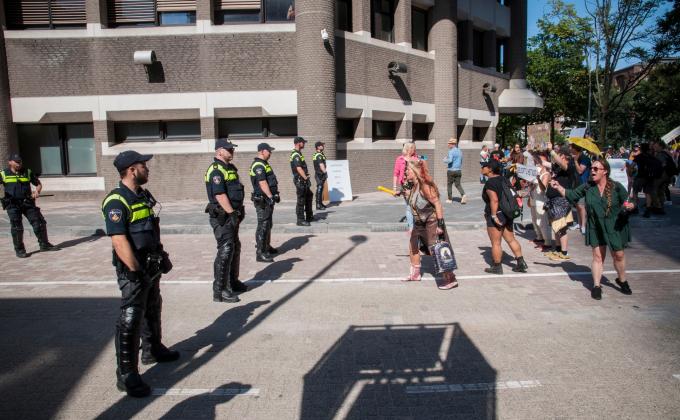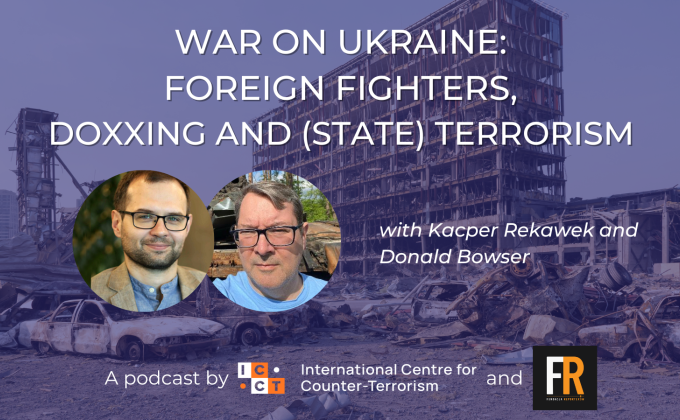Introduction
The recognition of misogyny as a motivating ideology for far-right mobilisation and acts of mass violence has been slow to evolve. Even as there has been a growth in attention to far-right movements and parties in Europe and the United States, this has primarily focused on racist and xenophobic ideology. Since 2018, however, this has begun to change.
In 2018, the Southern Poverty Law Center (SPLC) and the National Consortium for the Study of Terrorism and Responses to Terrorism (START) began to include male supremacy amongst the ideologies they track. The Anti-Defamation League (ADL) also began to look at misogynist ideology, writing in their 2018 report that first addressed the issue: “Every day, as virulent white supremacists make their hatred known, we immediately and rightly call them extremists. We have not been nearly as unequivocal in our condemnation when it comes to men who express violent anger toward and loathing for women.” Terrorist attacks connected to misogynist ideology that occurred in Toronto, Canada, and Tallahassee, Florida, US, in 2018, significantly influenced the changing media and public awareness of this threat.
Despite these changes, understanding of male supremacist terrorism remains far behind where it needs to be. As recently as August 2019, the New York Times published an article titled “White Extremist Ideology Drives Many Deadly Shootings,” even though the comprehensive timeline of attacks included misogynist perpetrators of mass violence who were mixed race—all the perpetrators, however, were male.
Elements of Male Supremacist Ideology
This ICCT Perspective examines male supremacism as a right-wing extremist ideology, one that has contributed to terrorist attacks, primarily in the US, but also in Canada and Europe. While there are a number of contemporary male supremacist communities (men’s rights activists, pickup artists, The Red Pill, MGTOW: Men Going Their Own Way) this article focuses on those ideologies directly connected to terrorism. Within secular male supremacist communities, the motivation for terrorist attacks stem predominantly from two core misogynist beliefs: 1) the belief that men are entitled to sexual access to women, which misogynist “incels”—men who identify as “involuntarily celibate”—have used to justify mass violence as retribution for being denied sex; and 2) the belief that feminists are a malevolent force controlling society at the expense of men, a frame similar to anti-Semitic conspiracy theories regarding Jewish elites controlling the world.
A recent ICCT Policy Brief referenced the increasing attention being paid to racist right-wing extremism in the US, and argued for the recognition of two additional categories of right-wing extremism in the US: “nativist extremism” and “anti-government extremism.” The article continues, “There are emerging forms of extremism (such as some forms of male supremacy oriented around a return to “traditional” gender hierarchies) and forms of single-issue RWE (like violent anti-abortion extremism) that do not fit into this schema,” and argues in a footnote that “some of the most prominent forms of male supremacy (such as the ‘incels’) are not right-wing but are best understood as their own form of extremism.” However, male supremacism, like white supremacism, is fundamentally a right-wing belief system, a characteristic that does not alter even when promoted by people who consider themselves Democrats or on the Left. Violent anti-abortion extremism as well is a form of male supremacism, one typically motivated by religious fundamentalism. This article focuses on the secular manifestations of male supremacism that have evolved and pose a growing terrorist threat today; despite this, religious and secular male supremacist ideologies are cut from the same cloth and both are substantially founded on the concept that men are entitled to control women’s bodies and decisions.
Misogyny has been referred to as a “gateway drug” into white supremacy and extremism by both researchers and journalists. A post on The Daily Stormer, a well-known neo-Nazi website, claimed, “Incels are full of rage, and it is trivial to turn these guys into kike [Jew] haters.” Nonetheless, misogyny/male supremacism should be recognised as a motivating ideology in and of itself—not just as a “gateway”—which can help researchers understand the significant presence of men of color in contemporary far-right movements, as has been observed for instance in the US Pacific Northwest.
Thus far, anti-feminist conspiracism is typically combined with other far-right ideologies when manifested in terrorist attacks, as in the case of Anders Breivik, who killed 77 people in Norway in 2011. Breivik’s xenophobia and Islamophobia ties closely into his belief in the right-wing conspiracy theory around “cultural Marxism,” or “political correctness,” which he views as a threat taking over Europe, with feminism identified in his manifesto as a “key, or even a dominant element.” Feminists are viewed as attempting to destroy traditional European culture through “feminisation” and support for Muslim immigration. Breivik’s manifesto credits “radical feminism” with control over the media, education, and government, and that “the last bastion of male domination, the police force and the military, is under assault.”
Aggrieved male sexual entitlement, in contrast, has appeared both in acts of mass violence that is motivated by other far-right beliefs, and as a primary motivator in of itself. Since 2014, there have been six successful acts of mass violence in the US and Canada in some way connected to incel ideology. From here forward, this article will focus on discussing incel-related terrorism, in which misogyny and aggrieved male sexual entitlement is the primary driver of violence.
Terrorist Intent in Misogynist Violence
When Scott Beierle opened fire at a yoga studio in Tallahassee in 2018, law enforcement initially seemed at a loss to suggest what might have behind the attack. They should not have been.
A yoga studio is a clear symbolic target for a misogyny based on thwarted male sexual entitlement, just as a synagogue is a symbolic target for anti-Semitism or a Black church for white supremacists—yoga pants and fitness clothes have also been particular targets of incel outrage. A yoga studio, a sorority, a fitness class: these are spaces associated with young attractive women, the women that incels feel entitled to and unjustly denied access to, and have been targets of violence driven by aggrieved male sexual entitlement. While some mass killers motivated by misogyny went for more general targets—campuses or busy streets—when this type of female-dominated space is selected, the symbolic association should immediately direct law enforcement to explore male supremacism as the motivation.
No misogynist killer articulated the terroristic intention behind his selected target more clearly than 22-year-old Elliot Rodger, who set out on his “War on Women” to “punish all females for the crime of depriving me of sex.” The autobiography he left behind—which has been taken as a manifesto for the incel ideology—spells this out. “I cannot kill every single female on earth, but I can deliver a devastating blow that will shake all of them to the core of their wicked hearts. I will attack the very girls who represent everything I hate in the female gender: The hottest sorority of [University of California, Santa Barbara].” He continues by describing these sorority women as selected for being “the kind of girls I’ve always desired but was never able to have.” (Rodger was unsuccessful in gaining access to the sorority and turned to killing people outside instead.)
Since Rodger, there have been at least five successful attacks, including Beierle’s, that referenced incel ideology or Rodger himself, and two more attempted acts of mass violence that were thwarted without fatalities. Dr. Kaitlyn Regehr, a digital culture expert at the University of Kent, states that “Elliot Rodger, really flips the switch from a community that is angry online, operating within the digital space, to a community that has the potential to carry out real acts of violence.”
Pre-dating the growth of misogynist incel forums, August 2009 saw another offline act of misogynist mass violence. The perpetrator, George Sodini, targeted women in a fitness class in Collier Township (Pittsburg), Pennsylvania, leaving behind a blog claiming his lack of sexual and romantic relationships as the reason for his attack. Sodini had been involved with learning techniques to attract women from the “seduction” or “pickup artist” industry, which is founded on gender stereotyping and dehumanizing sexism. However, Rodger’s attack differed to Sodini’s due to the growth of misogynist online forums by 2014, which he actively engaged with and credited as part of his radicalisation, saying that they confirmed “many of the theories [he] had about how wicked and degenerate women really are.” The process of online radicalisation has been documented in looking at white supremacist mass killers such as Dylann Roof who follow similar trajectories.
Rodger’s investment in explaining through his manifesto, videos, and forum posts how he—and other incels—faced sexual injustice for which mass violence was a justified response substantially shaped the trajectory of incel ideology and mass violence. “Going ER” [Elliot Rodger] has become incel slang for mass violence. The references to Rodger by incel mass killers that have followed over the past five years indicates that they are following in his footsteps, as he had hoped. On one forum, Rodger posted, “If we can't solve our problems we must DESTROY our problems…One day incels will realise their true strength and numbers, and will overthrow this oppressive feminist system. Start envisioning a world where WOMEN FEAR YOU.”
The Dangers of Thwarted Male Entitlement
Though Rodger claims to have been bullied in his autobiography, his rhetoric demonstrates the belief in his own superiority, which Kalish and Kimmel (2010) identified as a core characteristic of perpetrators in a study of school shooters: “the shooters felt both victimised by others and superior to them. They felt humiliated by their presumed inferiors.” Dr. Amy Barnhorst similarly explains that perpetrators of mass shooting demonstrate “this entitlement, this envy of others, this feeling that they deserve something that the world is not giving them. And they are angry at others that they see are getting it.”
The terrorist attack is a way for Rodger to reassert his superiority, to imagine himself as a “powerful god.” “How dare they reject a magnificent gentleman like me!” Rodger writes in his autobiography, expressing his sense of entitlement to access to women’s bodies. Women are treated as bringing this attack on themselves for their “crimes”—i.e. not dating him. Rodger emphasises his attack as a response to injustice, calling it his “Day of Retribution.” “How dare those girls give their love and sex to those other men and not me, I constantly think when I see young couples.”
Kalish and Kimmel developed the concept of “aggrieved entitlement,” described as “a gendered sense that [the male mass shooters] were entitled, indeed, even expected – to exact their revenge on all who had hurt them. It wasn’t enough to have been harmed; they also had to believe that they were justified.” In the misogynist incel community, the self-justification for violence laid out by Rodger becomes part of the foundation for a social movement ideology, in which individual grievance is transformed into a community-wide injustice premised on male sexual entitlement.
Although women were the primary targets of his hatred, Rodger’s envy of sexually successful men for enjoying what he believed himself entitled to provided justification for violence against men as a secondary target. Rodger—who was half-white, half-Asian, and considered his white ancestry superior—directed a particular racist sense of injustice toward sexually successful men of colour and disparagement toward full-Asian males. The incel community uses the terms “normies” and “Chads” to refer to non-incels and sexually successful men (“Tyrones” is an alternate term for Black men) along with “femoids” and other dehumanising terms for women. They have also applauded contemporary mass killers who do not share the incel identity, such as the October 2017 Las Vegas shooter who killed 58 people, for targeting “normies.” (Reddit finally banned the r/incels forum not long after.) The glorification of violence in the misogynist incel community has extended to claiming past perpetrators of mass violence as their own, such as the 2007 Virginia Tech shooting and even Oklahoma City bomber Timothy McVeigh.
The 2018 Toronto van attack is unique amongst mass violence connected to misogynist incel ideology because the perpetrator survived his own attack (though he had intended to die and attempted to provoke “suicide by cop”). This provided an opportunity to investigate his motivations and influences beyond the single statement he posted on Facebook about the attack: “Private (Recruit) Minassian Infantry 00010, wishing to speak to Sgt 4chan please. C23249161. The Incel Rebellion has already begun! We will overthrow all the Chads and Stacys! All hail the Supreme Gentleman Elliot Rodger.” The recently released police interview with perpetrator Alek Minassian reveals more starkly how Rodger’s rhetoric and example influenced his attack.
Minassian told police that he began to be “radicalised” by incel forums around the time of the 2014 attack, echoing Rodger in claiming, “I consider myself a supreme gentleman … I was angry that they would give their love and affection to obnoxious brutes.” Like Rodger, he referred to his attack as “the day of retribution,” and hoped to “inspire future masses to join me in my uprising.” Minassian’s trial will begin in February 2020. In January 2019, on the day of the Women’s March, Christopher Cleary planned a mass shooting at the rally in Provo, Utah, “killing as many girls as I see.” Cleary, who had a past history of stalking and threatening women, was arrested on terrorism charges based on his social media posts. Though it is unclear if Cleary participated in incel forums, his express motivation stemmed from the same sense of thwarted male sexual entitlement that justified mass killing, and by 2019, it seems unlikely that he had not been expose to incel ideology at all. Cleary pled guilty to a charge of attempted threat of terrorism, in what appears to be the first terrorism-related sentence given to a male supremacist perpetrator motivated primarily by aggrieved male sexual entitlement.
Law enforcement and military authorities have just this year started to recognise incels as threats to monitor.
Ignoring Red Flags
A number of the perpetrators connected to incel ideology, including Rodger and Beierle, had either been visited by the police due to concerns about online postings or had prior encounters with law enforcement regarding the harassment or assault of women. Cleary had been repeatedly sentenced to probation in stalking cases; in April 2018, a judge gave as his reason, “It won’t do the community any good if I put you in prison and make you worse,” even though prosecutors had sought a sentence to Community Corrections, a residential supervision and treatment program that is an alternative to prison. Cleary had previously been sentenced to probation for harassment in 2015; when his victim reported that he continued to harass her under different pseudonyms, law enforcement dismissed her with the claim that they could not be sure it was him. Danielle Citron, author of the book Hate Crimes in Cyberspace, commented that the criminal justice system tends to be dismissive of online abuse and that “perpetrators get empathy while ‘we forget and erase the victims.’”
Recently, a new awareness has arisen that mass shooters in most cases tend to be men with histories of violence or harassment of women, regardless of the motivating ideology. Some scholars caution that, lacking better data, the correlation could simply be due to the prevalence of domestic violence. This is hardly comforting, given that intimate partner violence is in of itself a manifestation of aggrieved entitlement, a process to terrorise victims, and the leading cause of female homicides in the U.S. This points to not only the need for more attention to male supremacism and misogyny, but also the need to expand our understanding of ideological and terrorist violence to incorporate the interpersonal physical and sexual violence rarely included in studying right-wing extremism.








